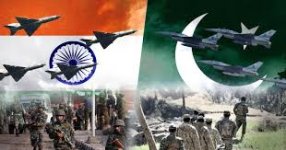The India-Pakistan war is a longstanding and complex conflict that has been ongoing for decades. The dispute between the two nations is rooted in historical, cultural, and territorial differences, with the primary point of contention being the Kashmir region. The conflict has led to several wars, including the Indo-Pakistani War of 1947, the Indo-Pakistani War of 1965, and the Indo-Pakistani War of 1971. The Kargil War in 1999 was a significant escalation of the conflict, with both countries engaging in a military standoff. The conflict has resulted in significant human suffering, displacement, and economic costs. Despite numerous attempts at peace negotiations and diplomatic efforts, a lasting resolution to the conflict remains elusive. The situation is further complicated by the presence of militant groups and terrorist organizations in the region, which has led to increased tensions and violence. The international community has called for a peaceful resolution to the conflict, with many countries urging both India and Pakistan to engage in dialogue and find a mutually acceptable solution.
Key Issues in the India-Pakistan Conflict
- Kashmir Dispute: The Kashmir region is a major point of contention between India and Pakistan, with both countries claiming sovereignty over the region.
- Terrorism: The presence of militant groups and terrorist organizations in the region has contributed to increased tensions and violence.
- Border Skirmishes: The India-Pakistan border has seen numerous skirmishes and ceasefire violations, resulting in human suffering and loss of life.
- Diplomatic Efforts: Despite numerous attempts at peace negotiations and diplomatic efforts, a lasting resolution to the conflict remains elusive.
Impact of the Conflict
- Human Suffering: The conflict has resulted in significant human suffering, displacement, and loss of life.
- Economic Costs: The conflict has had significant economic costs, with both countries diverting resources away from development and towards military spending.
- Regional Instability: The conflict has contributed to regional instability, with the potential for escalation and wider conflict.
Conclusion
The India-Pakistan war is a complex and ongoing conflict that requires a nuanced understanding of the historical, cultural, and territorial differences between the two nations. A lasting resolution to the conflict will require sustained diplomatic efforts, dialogue, and a commitment to finding a mutually acceptable solution.
#IndiaPakistanWar #KashmirDispute #Terrorism #BorderSkirmishes #DiplomaticEfforts #HumanSuffering #EconomicCosts #RegionalInstability #PeaceNegotiations #ConflictResolution
Key Issues in the India-Pakistan Conflict
- Kashmir Dispute: The Kashmir region is a major point of contention between India and Pakistan, with both countries claiming sovereignty over the region.
- Terrorism: The presence of militant groups and terrorist organizations in the region has contributed to increased tensions and violence.
- Border Skirmishes: The India-Pakistan border has seen numerous skirmishes and ceasefire violations, resulting in human suffering and loss of life.
- Diplomatic Efforts: Despite numerous attempts at peace negotiations and diplomatic efforts, a lasting resolution to the conflict remains elusive.
Impact of the Conflict
- Human Suffering: The conflict has resulted in significant human suffering, displacement, and loss of life.
- Economic Costs: The conflict has had significant economic costs, with both countries diverting resources away from development and towards military spending.
- Regional Instability: The conflict has contributed to regional instability, with the potential for escalation and wider conflict.
Conclusion
The India-Pakistan war is a complex and ongoing conflict that requires a nuanced understanding of the historical, cultural, and territorial differences between the two nations. A lasting resolution to the conflict will require sustained diplomatic efforts, dialogue, and a commitment to finding a mutually acceptable solution.
#IndiaPakistanWar #KashmirDispute #Terrorism #BorderSkirmishes #DiplomaticEfforts #HumanSuffering #EconomicCosts #RegionalInstability #PeaceNegotiations #ConflictResolution


